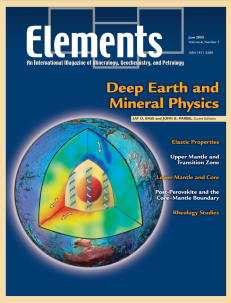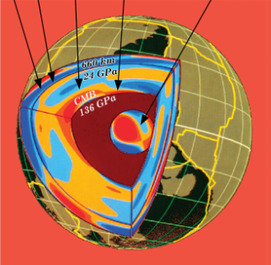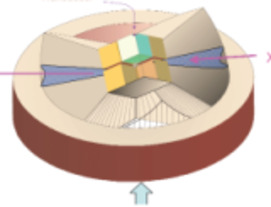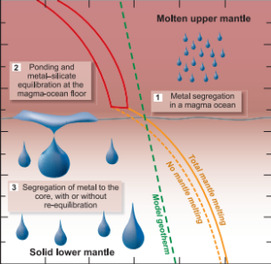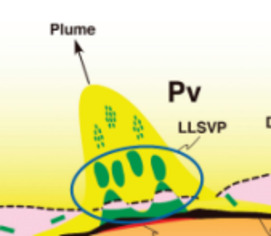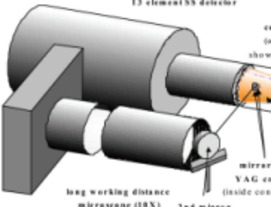
Deep Earth and Mineral Physics
Jay D. Bass and John B. Parise – Guest Editors
Table of Contents
The field of high-pressure mineral physics is cen- tral to our understanding of the Earth’s interior and its evolution. It is also a field that is rapidly advancing. Recent major discoveries, such as the post-perovskite phase transition that may explain some of the properties of the core–man- tle boundary, speak to the continued impor- tance of high-pressure mineral physics experiments. The results from experimental mineral physics along with seismological data are used to construct compositional and thermal models of the Earth and its heterogeneity, including inferences of deep geochemical reservoirs. These results are also key to understanding all plane- tary bodies in the solar system. This issue of Ele- ments will highlight several key areas of high- pressure mineral physics in a form that is accessible to a broad mineralogical audience.
Deep Earth and Recent Developments in Mineral Physics
Elastic Properties of Minerals: A Key for Understanding the Composition and Temperature of Earth’s Interior
The Upper Mantle and Transition Zone The Earth’s Lower Mantle and Core
Discovery of Post-Perovskite and New Views on the Core–Mantle Boundary Region
Laboratory Studies of the Rheological Properties of Minerals under Deep-Mantle Conditions
American Geophysical Union (AGU)
Bruker AXS
Cambridge University Press
Elsevier
Excalibur Mineral Corporation
Geological Society of London
Hudson Institute of Mineralogy
Institut national de la recherche scientifique
Meiji Techno America
Rigaku
RockWare
Thermo Fisher Scientific
v4n4 Platinum-Group Elements
Guest editor: James M. Brenan and James E. Mungall (University of Toronto)
Storage of carbon in the sub- surface involves introduction of supercritical CO2 into rock formations beneath the sur- face of the Earth, typically at depths of 1000 to 4000 meters. Although CO2 is a relatively benign substance, the volume being considered is large. If developed to its envisaged potential, geologic sequestra- tion will entail the pumping of CO2 into the ground at roughly the rate we are extracting petroleum today. To have the desired impact on the atmospheric carbon budget, CO2 must be effi- ciently retained underground for hundreds of years. Any underground storage sys- tem will have to account for the natural characteristics of subsurface formations; some are advantageous for storage while others are not. When foreign materials are emplaced in subsurface rock formations, they change the chemical and physical environment. Understanding and predicting these changes are essential for deter- mining how the subsurface will perform as a storage container. The specific scien- tific issues that underlie sequestration technology involve the effects of fluid flow combined with chemical, thermal, mechanical, and biological interactions between fluids and surrounding geologic formations. Complex and coupled interactions occur both rapidly as the stored material is emplaced underground, and gradually over hundreds to thousands of years. The long sequestration times needed for effec- tive storage and the intrinsic spatial variability of subsurface formations provide challenges to both geoscientists and engineers. A fundamental understanding of mineralogical and geochemical processes is integral to this success.
The Platinum-Group Elements: “Admirably Adapted” for Science and Industry James M. Brenan (University of Toronto)
- Platinum-Group Elements in Cosmochemistry Herbert Palme (Universität zu Köln)
- Applications of PGE Radioisotope Systems in Geo- and Cosmochemistry Richard W. Carlson (Carnegie Institution of Washington), Steven B. Shirey (Carnegie Institution of Washington) and Maria Schönbächler
- Platinum-Group Elements: A New Set of Key Tracers for the Earth’s Interior Jean-Pierre Lorand (Museum National de l’Histoire Naturelle), Ambre Luguet (Université du Québec à Chicoutimi), and Olivier Alard (Université de Montpellier)
- Ore Deposits of the Platinum-Group Elements James E. Mungall (University of Toronto) and Anthony J. Naldrett (University of Toronto)
- Environmental Relevance of the Platinum-Group Elements Sebastien Rauch and Gregory M. Morrison (Chalmers University of Technology)
- Supervolcanoes (February 2008)
- Phosphates and Global Sustainability (April 2008)
- Deep Earth and Mineral Physics (June 2008)
- Platinum-Group Elements (August 2008)
- Carbon Dioxide Sequestration (October 2008)
- Nanogeoscience (December 2008)
Download 2008 Thematic Preview


